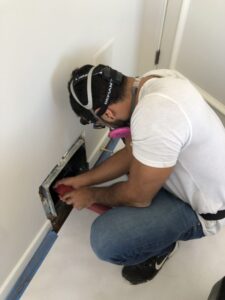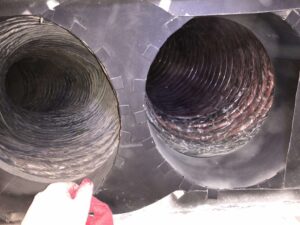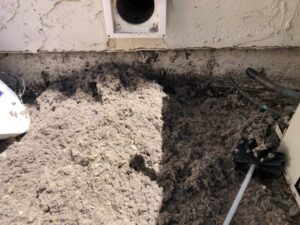Signs Your Air Ducts Need Cleaning: What to Look For
Spotting signs that you need air duct cleaning can be the difference between a healthy and comfortable home and unknowingly breathing in dust, allergens, and mold. If your vents are blowing more than just air, your HVAC system may not be working as it should. Here’s how to recognize the hidden warning signs before they turn into bigger problems.

Why Clean Air Ducts Are Essential for Home Comfort
The condition of your air ducts impacts air quality, HVAC performance, and other aspects of your home’s comfort. When they become clogged with dust and debris and circulate these pollutants through your home and HVAC system, your indoor comfort suffers. Regular cleaning helps maintain a healthy ductwork system.
Improves Indoor Air Quality
Air ducts circulate air throughout a home, and particles from debris buildup inside air ducts can become airborne. As they spread across your living areas and worsen indoor air quality, household members may experience increased allergy symptoms and other discomfort. Common airborne contaminants include:
- Dust and dust mites
- Pet dander
- Pollen
- Mold spores
- Bacteria and viruses
- Volatile organic compounds (VOCs)
Clean air ducts help reduce these irritants, contributing to fresher and healthier air.
Enhances HVAC Efficiency and Performance
Dust and debris buildup in ducts restricts airflow, forcing your HVAC system to work harder to cool or heat your home. It can also spread throughout your system, coating important components and preventing them from operating as they should. A dirty evaporator coil, for example, limits the heat exchange process between the air and refrigerant, limiting AC performance and increasing the likelihood of frozen coils, leaks, and other problems.
Duct cleaning prevents obstructions from limiting airflow and disrupting the ductwork balance. With air moving as it should and with minimal contaminants, your HVAC system should experience enhanced efficiency, performance, and longevity.
Prevents Mold Growth and Odors
Air ducts are prone to humid environments that are ideal for mold growth. When moisture and organic matter accumulate, mold spores eventually germinate and grow. Mold spores contaminate the air and travel throughout your home, contributing to respiratory and cold-like symptoms and unpleasant musty odors from vents. Regular inspections and cleaning suppress and remove mold to maintain a fresh and spore-free indoor space.

Common Signs Your Air Ducts Need Cleaning
Recognizing these signs helps alert you to dirty ducts before they escalate into more severe problems.
Excessive Dust Buildup in Vents and Registers
A noticeable layer of dust around supply and return vents suggests excessive dirt and debris circulating in your ductwork. When ducts become clogged, other surfaces in your home may also have greater dust buildup. If dust accumulates quickly despite regular cleaning, your ducts may be the problem.
Unexplained Allergy or Respiratory Issues
Airborne contaminants may cause allergy or respiratory symptoms to worsen indoors. If your symptoms improve when you’re away from home, you may be exposed to pollutants from your ductwork.
Mold or Mildew Smells
A persistent musty odor in your home may indicate mold in air ducts, especially if the smell is concentrated near the vents and intensifies during an AC or heating cycle. In some cases, mold may appear around the event openings, inside ducts, or on the evaporator coil.
Inconsistent Airflow
If your HVAC system struggles to cool or heat your home evenly, clogged air ducts may be restricting airflow. Hot or cold spots are most likely to occur near vents or in the areas furthest from vents.
Frequent HVAC Filter Clogs
HVAC filters typically require replacement every 30 to 90 days, depending on your home’s indoor conditions, but more frequent replacements than usual may suggest excessive debris traveling from the ductwork.
Increased Energy Bills
An inexplicable increase in energy bills may indicate HVAC efficiency problems stemming from ductwork problems.
What Happens If You Ignore Dirty Air Ducts?
Neglecting air duct maintenance may have long-term consequences for your household’s health and home comfort.
Poor Indoor Air Quality and Health Issues
People with asthma, allergies, or other respiratory conditions may be especially sensitive to contaminants circulated by dirty air ducts. Poor indoor air quality may exacerbate symptoms of preexisting conditions or cause other household members to experience sneezing, itchy eyes, difficulty breathing, and other respiratory discomfort. Long-term exposure to poor indoor air quality may have severe health consequences, particularly for children, seniors, and those with pre-existing conditions.
HVAC System Wear and Breakdowns
Dirty components, restricted airflow, and other inefficiencies associated with poor ductwork conditions accelerate wear on your HVAC system. As components strain and wear more quickly to match heating or cooling demands, your HVAC system is subject to an increasing risk of overheating, damage, and failure. Left unaddressed, excessive HVAC strain may result in costly repairs and even premature system replacement.
Fire Hazards
Although ducts may not cause a fire, accumulated dust, lint, and debris can be highly flammable. If ducts are near electrical wiring or heat sources, excessive dirt may increase fire risk.
Mold Growth and Structural Damage
If ducts develop extensive mold, it can spread throughout your home and damage walls, ceilings, and flooring. Mold may rot and weaken building structures, sometimes requiring remediation and structural repairs.
How Often Should You Get Your Air Ducts Cleaned?
Ducts require cleaning every three to five years, but the frequency of air duct cleaning depends on various household and environmental factors. These include:
- Homes with pets
- Household members with allergies or asthma
- Recent home renovations
- Humidity levels
- Excessive smoking or cooking indoors
- Regional air quality
If any of these conditions, your home and indoor air quality may benefit from more frequent duct cleaning services. An HVAC technician can also inspect and assess your ductwork during routine maintenance visits to determine whether your air ducts require cleaning.

Schedule Professional Air Duct Cleaning With TRIO Heating, Air & Plumbing
TRIO Heating, Air & Plumbing provides thorough air duct cleaning to remove dust, allergens, and contaminants, protecting your home and optimizing HVAC system performance. Contact us and schedule professional duct cleaning with TRIO Heating, Air & Plumbing to improve air quality and HVAC efficiency.
